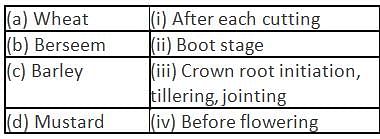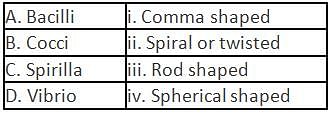Agriculture: CUET Mock Test - 3 - CUET Humanities MCQ
30 Questions MCQ Test Agriculture Practice Tests: CUET Preparation - Agriculture: CUET Mock Test - 3
Which of the following is a causal organism of foot and mouth disease?
| 1 Crore+ students have signed up on EduRev. Have you? Download the App |
Fatty acid molecules containing one or more double bonds (— HC = CH—) are called:
Which of the following is not a cause of disruption of a pest's life-cycle?
Which vegetable can endure the coldest temperatures and frost the best compared to cauliflower?
Meiosis II is divided into four phases. The centromere of each chromosome divides into two so that there is one centromere for each chromatid in
Which of the following is the correct sequence in crop production?
Several fine roots-like hyphae that penetrate into the substrate are called _______.
The practice of growing two or more crops simultaneously in a fixed pattern is known as
The pH value decreasing from 7 (like 7,6,5, 4,3……) on pH scale indicates:
Animal semen for breeding of animals remains fertile for a long time at:
Water is needed mainly to meet the demands of:
A. Evaporation
B. Transpiration
C. Metabolic needs
Which of the following is not related with the pulse crops?
Which of the following features demonstrates horticulture's importance?
Which gas helps in increasing the dough size of the bread?
Weeds should be removed from a crop field as early as possible because
Which of the following is a hybrid variety of rice developed in India?
Four farmers A → D adopt different farming practices. In which of the following cases will there be maximum benefits?
From the following statements, which statement is correct?
(A) Care should be taken to remove weeds in early stages of crop.
(B) Hand weeding has to be carried out thrice in 3 weeks to 4 weeks after sowing and 5 weeks to 6 weeks after sowing.
Select the correct answer about manure.
(a) Manure contains large quantities of organic matter and small quantities of nutrients.
(b) It increases the water holding capacity of sandy soils.
(c) It causes water logging in clayey soil.
(d) Its excessive use pollutes environment because it is made up of animal excretory waste.
Which of the following is/are not included in organic farming?
Which revolution is satisfying the primary aim appropriately?
Match the following crops with the corresponding critical stages for irrigation.





















